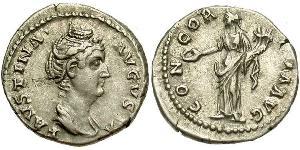|
||||||||||||

Annia Galeria Faustina, more familiarly referred to as Faustina I (Latin: Faustina Major; born on September 21, in about 100; died in October or November of 140[1]), was a Roman Empress and wife of Roman Emperor Antoninus Pius.
Early life[edit]
Faustina was the only known daughter of consul and prefect Marcus Annius Verus and Rupilia Faustina. Her brothers were consul Marcus Annius Libo and praetor Marcus Annius Verus. Her maternal aunts were Roman Empress Vibia Sabina and Matidia Minor. Her paternal grandfather had the same name as her father and her maternal grandparents were Salonina Matidia (niece of Roman Emperor Trajan) and suffect consul Lucius Scribonius Libo Rupilius Frugi Bonus. Faustina was born and raised in Rome.
As a private citizen, she married Antoninus Pius between 110 and 115. Faustina and Antoninus had a very happy marriage. Faustina bore Antoninus four children, two sons and two daughters. They were:
- Marcus Aurelius Fulvius Antoninus (died before 138); his sepulchral inscription has been found at the Mausoleum of Hadrian in Rome.
- Marcus Galerius Aurelius Antoninus (died before 138); his sepulchral inscription has been found at the Mausoleum of Hadrian in Rome. His name appears on a Greek Imperial coin.
- Aurelia Fadilla (died in 135); she married Aelius Lamia Silvanus or Syllanus. She appears to have had no children with her husband and her sepulchral inscription has been found in Italy.
- Annia Galeria Faustina Minor or Faustina the Younger (between 125-130-175), a future Roman Empress; she married her maternal cousin, future Roman Emperor Marcus Aurelius. She was the only child who survived to adulthood.
Empress[edit]
On July 10, 138, her uncle, Emperor Hadrian, died and her husband became the new emperor, as Antoninus was Hadrian's adopted son and heir. Faustina became Roman Empress and the Senate accorded her the title of Augusta. As empress, Faustina was well respected and was renowned for her beauty and wisdom. The Historia Augusta criticized her as having "excessive frankness" and "levity". Throughout her life, as a private citizen and as empress, Faustina was involved in assisting charities for the poor and sponsoring and assisting in the education of Roman children, particularly girls.
Death and legacy[edit]

When Faustina died in 140, Antoninus was devastated and took several steps to honor her memory. He deified her (her apotheosis was portrayed on an honorary column) and had the Temple of Faustina built in the Roman Forum. He also ordered various coins with her portrait struck, inscribed DIVA FAVSTINA ("Divine Faustina") and elaborately decorated. Antoninus also established a charity called Puellae Faustinianae ("Girls of Faustina") to assist orphaned Roman girls and created a new alimenta (see Grain supply to the city of Rome).
In 2008, archaeologists digging at the ancient site of Sagalassos in Turkey discovered a colossal marble head which is believed to be that of Faustina.[3]
Nerva–Antonine family tree[edit]
- (1) = 1st spouse
- (2) = 2nd spouse (not shown)
- (3) = 3rd spouse
- Darker purple indicates Emperor of the Nerva-Antonine dynasty; lighter purple indicates designated imperial heir of said dynasty who never reigned
- dashed lines indicate adoption; dotted lines indicate love affairs/unmarried relationships
- small caps = posthumously deified (Augusti, Augustae, or other)
Notes[edit]
- ^ Birley, Anthony. Marcus Aurelius, Routledge, p. 243. Routledge, 2000. ISBN 0-415-17125-3
- ^ "Belt Section with Medallions of Constantius II and Faustina". The Walters Art Museum.
- ^ BBC News, Head of Roman empress unearthed
Sources[edit]
| Wikimedia Commons has media related to Faustina Major. |
| Wikisource has the text of a 1920 Encyclopedia Americana article about Faustina the Elder. |
- http://www.roman-emperors.org/tonypis.htm
- http://www.lawrence.edu/dept/art/buerger/catalogue/098.html
- http://rpc.ashmus.ox.ac.uk/imperial/faustina-i/
- http://www.livius.org/fa-fn/faustina/faustina_i.html
- http://www.forumancientcoins.com/numiswiki/view.asp?key=Faustina%20Senior
| Royal titles | ||
|---|---|---|
| Preceded by Vibia Sabina |
Empress of Rome 138–141 |
Succeeded by Annia Galeria Faustina Minor |
|









